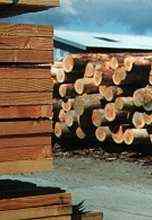The Australian Pesticides and Veterinary Medicines Authority (APVMA) has now ruled (see the new from March 18) that treated pine timber would be phased out for use in play equipment, outside seating and domestic decking by next March although it would continue to be used for general construction, fencing, signage and telephone poles.

Arsenic is a constituent of the common CCA (chromated copper arsenate) wood preservative. In this agent, copper acts as a fungicide, arsenic acts as an insecticide and chromium acts as a fixing agent. Recent studies have highlighted the fact, that the toxic inorganic trivalent arsenic (As(III)) and also hexavalent chromium is leached from treated timber by rain [1], leading to pollution of the nearby environment [2-6]. Air pollution can also be expected to take place, when CCA treated limber is burned [7, 8]. Even more alarming is the finding, that the toxic components can be dislodged from the timber surface by contact [9], leading to especially problematic scenarios when watching children playing in wooden playgrounds [10]. Children aged three to five were deemed high-risk because they were most likely to put their fingers in their mouths.
Public or regulator concerns, principally about CCA's arsenic content, have led to restrictions on its use in countries including Japan, Indonesia, Sweden and Germany. Britain and Canada also have banned its use in recreational items such as play equipment. Starting 1 January 2004, the U.S. Environmental Protection Agency (EPA) has banned CCA as a preservative for wood intended for residential use. Uses by utilities, for example in power poles, and in industry and agriculture are not affected.
Despite the ban in the United States, the CCA-treated wood is used in many existing structures in residential decks and public playgrounds. Approximately 70% of single-family homes in the United States have decks and porches containing CCA, and 14% of public playgrounds have CCA wood structures (U.S. EPA 2002a, 2003a, 2003b, 2004).
The Australian Pesticides and Veterinary Medicines Authority (APVMA) has now ruled that treated pine timber would be phased out for use in play equipment, outside seating and domestic decking by next March, although it would continue to be used for general construction, fencing, signage and telephone poles. The timber-treatment industry on both sides of the Tasman has strongly opposed any prohibition. Wayne Coffey, the director of New Zealand's Timber Industry Federation (TIF) argued that "New Zealand's Environmental Risk Management Authority had reviewed the product and could not find any reason to restrict its use; it was declared safe".
NSW State Forests also raised concerns the restrictions would adversely affect the sale of "acceptable" products made from treated timber.
Related scientific publications:
[1] Bernine I. Khan, Helena M. Solo-Gabriele, Brajesh K. Dubey, Timothy G. Townsend, Yong Cai,
Arsenic Speciation of Solvent-Extracted Leachate from New and Weathered CCA-Treated Wood, Environ. Sci. Technol., 38 (2004) 4527-4534.
DOI: 10.1021/es049598r
[2] M. Aceto, A. Fedele, Rain water effects on the release of arsenic, chromium and copper from treated wood, FEB Fresenius Environ. Bull., 3/7 (1994) 389.
[3] D.E. Stilwell, K.D. Gorny,
Contamination of soil with copper, chromium, and arsenic under decks built from pressure-treated wood, Bull. Environ. Contam. Toxicol., 58/1 (1997) 22-29.
DOI: 10.1007/s001289900295
[4] T.G. Townsend, H. Solo-Gabriele, T. Tolaymat, K. Stook,
Impact of chromated copper arsenate (CCA) in wood mulch, Sci. Total Environ., 309/1-3 (2003) 173-185.
DOI: 10.1016/S0048-9697(03)00047-0
[5] Gérald J. Zagury, Réjean Samson, Louise Deschênes,
Occurrence of Metals in Soil and Ground Water Near Chromated Copper Arsenate-Treated Utility Poles, J. Environ. Qual., 32/2 (2003) 507-514.
DOI: 10.2134/jeq2003.5070
[6] T. Chirenje, L.Q. Ma, C. Clark, M. Reeves,
Cu, Cr and As distribution in soils adjacent to pressure-treated decks, fences and poles, Environ. Pollut., 124/3 (2003) 407-417.
DOI:10.1016/S0269-7491(03)00046-0
[7] J. Aggett, A.C. Aspell, Arsenic contamination in an apple orchard, Environ. Pollut., A22 (1980) 39-46.
[8] E.H. Larsen, L. Moseholm, M.M. Nielsen, Atmospheric deposition of trace elements around point sources and human health risk assessment. II: Uptake of arsenic and chromium by vegetables grown near a wood preservation factory, Sci. Total Environ., 126/3 (1992) 263-275.
[9] D. Stilwell, M. Toner, B. Sawhney,
Dislodgeable copper, chromium and arsenic from CCA-treated wood, Sci. Total Environ., 312/1-3 (2003) 123-131.
DOI:10.1016/S0048-9697(03)00195-5
[10] Elena Kwon, Hongquan Zhang, Zhongwen Wang, Gian S. Jhangri, Xiufen Lu, Nelson Fok, Stephan Gabos, Xing-Fang Li, X. Chris Le,
Arsenic on the Hands of Children after Playing in Playgrounds, Environ. Health Perspect., 112/14 (2004) 1375.
DOI: 10.1289/ehp.7197
Related information:
BANCCA.ORG: The premier online health resource for consumers of CCA Pressure Treated Wood
http://www.bancca.org/
Environmental Protection Authority Victoria, Australia: Ash from CCA-treated timber
last time modified: October 12, 2024